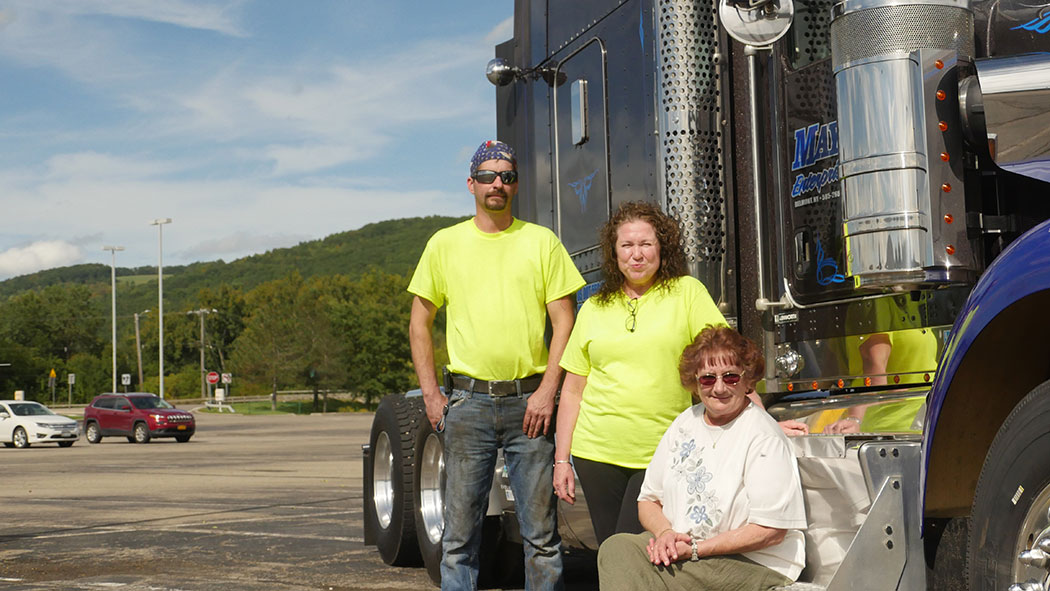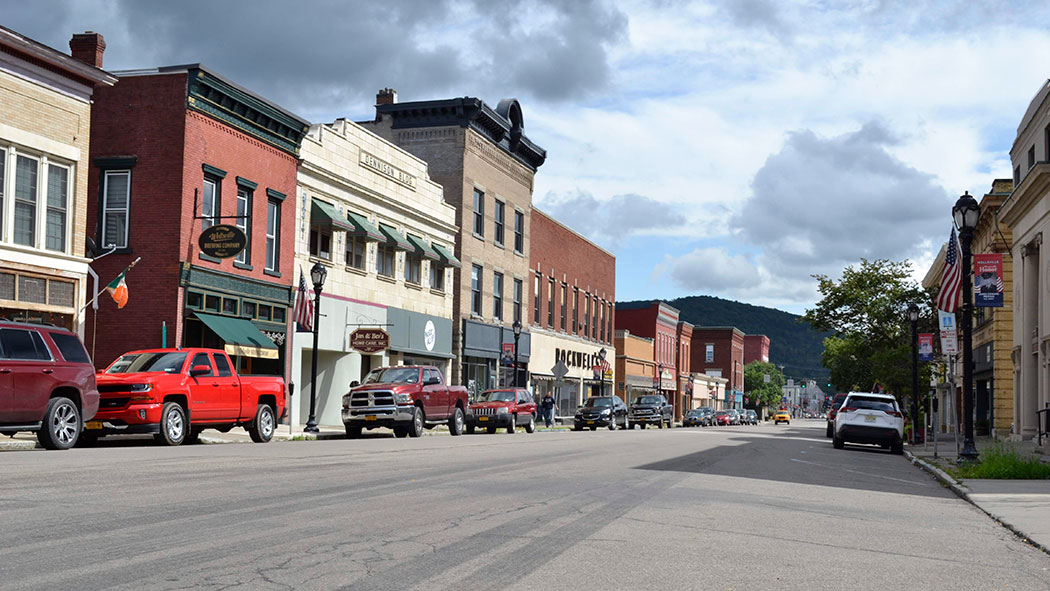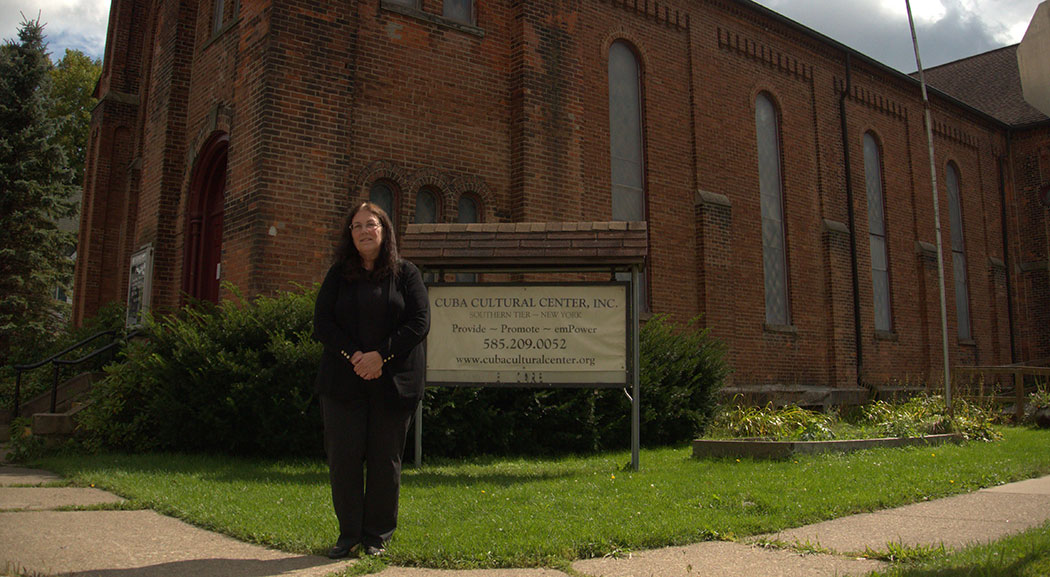New York State
Has Trump made upstate great again?
Outside its urban centers, much of New York voted heavily for Donald Trump. But the president hasn’t fulfilled his promise to fix the rural and Rust Belt economy.

Trump country cow. Photo illustration by Aaron Aniton
In the rolling hills of Allegany County the din of work – jackhammers striking pavement, the low drone of machines in factories, tractors scraping the soil – has been a constant for centuries.
But the Southern Tier, the heavily wooded stretch of rural New York that runs along the border with Pennsylvania, has seen better days. Persistently high unemployment, poverty and depopulation have hit the region hard in recent decades, in part because of the deindustrialization that brought job losses throughout the state.
It’s no wonder that Allegany County, a Republican stronghold in the middle of the Southern Tier, was so receptive to President Donald Trump’s many promises to industries that have been crucial to the region’s economy, including agriculture, manufacturing and natural resource extraction. The people there voted for Trump over Democratic candidate Hillary Clinton by more than 40 percentage points in 2016 – a big increase from the 24-point margin they gave Republican Mitt Romney in 2012.
Allegany County – which covers a sparsely populated area about an hour’s drive southeast of Buffalo – and similar places are where Trump enjoys his greatest support in his home state. While Staten Island may get much of the media attention as New York’s Trump Country because of its swing congressional district, voters supported Trump in many rural upstate counties by much wider margins. In Allegany County, Trump flags dot the countryside and the overwhelming majority of people interviewed for this story support the president.
But has Trump delivered on the promises he made to these New Yorkers? During the campaign and throughout his time in office, he told farmers that his trade policies would make them better off in the long run. He promised to open up more opportunities for fossil fuel companies. And he promised to bring back factory jobs. “It’s going to be a victory for the people,” Trump told a Michigan crowd during the 2016 campaign. “A victory for the wage-earner, the factory worker, a victory for the everyday citizen, and for all the people whose voice hasn’t been heard.”
While manufacturing jobs were growing at a fast clip through the first years of his presidency, a continuation of an overall upward trend since 2011, the growth appears to be faltering, with factory jobs dipping in the past few months.
Even a strong national economy doesn’t necessarily do much to benefit the struggling post-industrial areas that delivered votes for Trump. For decades, upstate has increasingly lagged behind downstate in economic and population growth. While upstate has seen an increase in jobs on the whole since 2010, it trails far behind New York City and its suburbs. The 12 downstate counties made up 88% of the 1.1 million jobs gained between 2010 and 2018, according to a report from the Empire Center for Public Policy. Over that period, 10 of New York’s 62 counties, including Allegany, Cattaraugus and Chautauqua counties, the bulk of the Southern Tier, actually lost private sector jobs. The slight rebound in manufacturing jobs seen in Greater Buffalo has not spread to the Southern Tier and other rural New York counties.
Trump said he would reverse the decline of the Rust Belt and rural America, but the economic reality in Allegany County and other struggling upstate areas suggests that his policies haven’t helped – and sometimes even done more harm than good.

While Trump and members of his administration assert that his aggressive trade policies, most notably the use of tariffs, will pay off in the long run, the short-term damage is undeniable. Trump’s tariffs cost U.S. businesses $3.4 billion in June alone, according to U.S. Census Bureau data. Retaliatory actions imposed on U.S. exports by China and other countries have made American products, especially crops, less competitive.
Christian Yunker, a third-generation farmer whose CY Farms grows corn, soybeans and other crops throughout rural Western New York, has seen firsthand the harm caused by tariffs. Though he’s a Republican, he did not vote for Trump in 2016 and will not vote for him next year, he said.
Many of his fellow farmers have bought into the idea pushed by the White House that the tariffs will be good for the U.S. economy and, ultimately, for them in the long run – but not Yunker. “I’m not sure I necessarily disagree that his intentions are to help the farmers,” he said. “I just think it’s a disaster how he’s gone about doing it.”
“(Farmers) end up being the whipping boys of the trade war, because we’re very easy to retaliate against.” – Christian Yunker, CY Farms owner
Economists tend to agree. As Tom Pogue, a professor of economics at the University of Iowa, explained, the problem with tariffs is that they need to be in place for a long period of time to be effective at reviving a domestic industry – perhaps longer than those affected are willing to tolerate and even longer than Trump will be in office, even if he wins another term. Businesses aren’t going to make decisions on where to build a factory or new offices based on a policy that could change within the next few years when those facilities might be used for the next 25 years, he added. “When (Trump) talks about doing these kinds of things, he’s not talking about something, in my judgment, that is very realistic,” Pogue said.
Yunker said it’s frustrating to always be on the front lines of economic policy, as is so often the case for farmers. “We end up being the whipping boys of the trade war, because we’re very easy to retaliate against,” Yunker said.
While the icy trade relationship between the world’s two largest economies has shown some signs of thawing amid a new round of trade talks in recent weeks, great damage has already been inflicted on both sides. U.S. farmers are scrambling to find affordable storage as their crops rot, shut off from one of their biggest markets. China bought almost $6 billion in U.S. agriculture exports in 2018.
Even if Trump loses the election next year, the implications for many farmers could be long lasting, putting some farms out of business, Yunker said. “While Trump is in office, I don’t know if there’s going to be much change in strategy,” he said. “I’m afraid he’s done long-term damage, even if the administration changes.”
Yunker is atypical politically, however. Like many people in the area, Darleen Krisher-Meehan, the president of the Allegany County Farm Bureau, labels herself as an independent. But she voted for Trump and said she likely will again. Krisher-Meehan said she knows business owners in the steel and lumber industries who have been hurt by Trump’s tariffs, but she hasn’t seen much of a difference for her own business selling seeds.
In her estimation, it is the state’s policies – the rising minimum wage, the bill passed this year giving farmworkers the right to organize – that are doing real damage to the upstate economy. Gov. Andrew Cuomo’s 2014 ban on hydraulic fracturing was a big hit to her business, she said, because energy companies used to buy huge amounts of seeds and hay to replace grass destroyed during the drilling and pipeline construction process.
Trump, while making promises to the Rust Belt in general, has also laid the blame for economic stagnation in some rural upstate communities at the feet of state politicians. “If New York isn’t going to treat them better, I would recommend they go to another state where they can get a great job,” Trump said of upstate residents earlier this year.
While Krisher-Meehan thinks environmental deregulation might help the area’s economy a little, she has a more jaded take on the ability of any politician to reverse the fortunes of Allegany County. She points to the long-standing issues surrounding the low price of milk and extremely thin profit margins for dairy farmers as an example. “Our farmers around here, it really boils down to they want a fair price for their milk,” Krisher-Meehan said. “And I don’t think any politician’s ever going to be able to fix that.”

In 2016, just two years after being bought by General Electric Co., Lufkin-RMT, an oil and gas equipment manufacturer in Wellsville, shuttered, costing 54 people their jobs. The D.F. Stauffer Biscuit Co. Inc. plant in the town of Cuba closed in 2017, costing another 51 people their jobs.
It’s about to get much worse in Allegany County. Dresser-Rand Corp., a longtime mainstay in Wellsville, is closing its doors next year, a decision made after another multinational company, Siemens AG of Germany, came in and gobbled them up. Now 250 more people are trying to figure out how they’re going to get by.
“There’s a lot of what you might call hidden poverty here – people who are proud and find it very difficult to ask for help.” – Suzanne Flierl Krull, founding member of the Cuba Cultural Center
The county’s population has been slowly, steadily declining for 40 years, going from 51,742 in 1980 to 46,430 in 2018, according to census statistics. Almost everyone has seen a family member or good friend leave to find work.
Suzanne Flierl Krull has been on the front lines of rural poverty for more than a decade. As a founding member of the Cuba Cultural Center, she has been helping to feed people in need in the town of Cuba, through many ups and downs.
Now, she said, things seem as bad as they have ever been. Their food pantry program is consistently seeing new faces. “Our numbers are growing,” Flierl Krull said. In Allegany County, the poverty rate remains at 16.3%, higher than both the state and nation as a whole.
People in the area are often reluctant to utilize the food pantry program because they don’t want to be seen as needy or to have their self-reliance called into question, she said. “There’s a lot of what you might call hidden poverty or hidden struggle here – people who are proud and find it very difficult to ask for help.”
Once, abundant factory jobs meant that you could walk out of high school and start a 40-year career with good pay and benefits. Today, due in large part to automation, manufacturing positions often involve operating robots rather than performing manual labor on an assembly line, so those jobs may require a college degree. And these trends are only going to continue as automation will continue to decrease the need for labor and make certain that the remaining jobs will be for high-skilled workers, a factor the president has failed to address in promising to bring factory jobs back from overseas through better trade agreements. As tech website Gizmodo noted, “His inattention to the subject moved the Harvard Business Review to speculate about why he never tweeted about automation. His Treasury Secretary, Steven Mnuchin, even once said automation-driven job loss ‘was not even on our radar screen.’”
In farming, the number of people working has decreased from more than 4.5 million in 1970 to more than 3 million in 2000, and the structure of the industry continues to shift. Fewer family farms exist, while the number of large farms continues to grow. As a result, the share of labor done by contractors and hired hands grew from 25% in 2003 to 41% in 2016, according to the U.S. Department of Agriculture. And the number of farms in New York state shrunk by 6% from 2012 to 2017, twice the decline that occurred nationwide over the same period, according to the USDA.
While the unemployment rate in Allegany County has gradually fallen, as it has throughout the country over the past eight years, the county still has one of the highest jobless rates in the state. At 5.2% in August, the county trails both the state and national averages, which are 4% and 3.7%, respectively.

Declining farm exports and shuttering factories are not the only economic disappointments for New York’s Trump Country under this administration. In other ways, national economic policy has failed to generate growth.
Consider Trump’s trademark initiative that was advertised as a surefire boost to the economy: the 2017 tax law, passed by his Republican allies in Congress. Trump swore that by cutting rates on the rich and corporations, it would steeply accelerate economic growth.
“This huge tax cut will be rocket fuel for our economy,” he told the National Association of Manufacturers shortly before the bill’s passage.
The immediate benefits, accruing mostly to the wealthy, didn’t do much for lower-income upstate areas. The tax law also disproportionately affected high-wage, high-tax blue states like New York through a new $10,000 cap on state and local tax deductions.
And now it seems that the promises of economic growth that came with an initial surge after the passage of the bill have fizzled. Trump and his acolytes promised a growth rate of at least 3%. In 2018, the first full year of the tax breaks, the national economy grew at 2.9% and it slowed to 2.1% in the second quarter of 2019. The economy hasn’t shown much of a boost from the tax cuts, according to many economists, and there are signs of a possible recession on the horizon.
Trump also promised an economic bonanza through the deregulation of polluting industries, such as fossil fuels. New York doesn’t produce much natural gas or crude oil, however, and it does not mine any coal.
So what would a better economic future for rural upstate look like? Capitalizing on some of the amenities that rural communities offer, such as outdoor recreation and picturesque main streets, has already reversed population decline in some rural areas by attracting retirees, smaller companies and people who are able to work remotely.
This is already happening in some parts of rural New York. Ontario County, with its thriving tourism and agricultural scene built up around Finger Lakes wineries, has a lower unemployment rate than Manhattan.
And some rural communities, such as Pottawattamie County, Iowa, are proving that formulating and executing a regional economic plan that builds off strong industries and capitalizes on new trends can succeed.
Telecommuting may also enable more migration from cities. The idea of living outside of stressful urban environments could draw workers disillusioned with long commutes and outrageous real estate costs. You can buy a five-bedroom, 3,200-square-foot home for $121,000 in Wellsville. “There is a counter force, I think, that may be offsetting some of this (population decline),” Pogue said.
Still, Pogue cautioned, it will be hard for most rural places to completely overcome the economies of scale and other factors that have been driving people out of the country and into metropolitan areas.
That’s a belief shared by many in Allegany County, their favored presidential candidate’s sales pitch notwithstanding. Expressing the weary resignation of many, Krisher-Meehan said: “I don’t think you’re going to fix what’s going on in these rural areas as far as poverty.”
Correction: A photo caption originally misidentified the occupations of Andrew Jefferds, Christine Jefferds and Kim McDowell.

NEXT STORY: Attacks on third parties and Andy King officially suspended